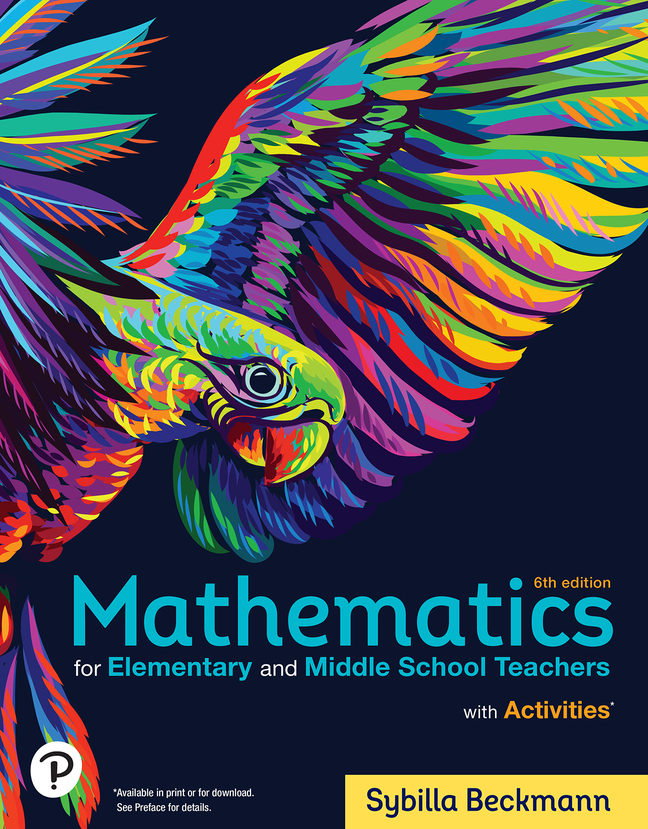
Mathematics for Elementary and Middle School Teachers with Activities, 6th edition
- Sybilla Beckmann

- Find it fast
Quickly navigate your eTextbook with search
- Stay organized
Access all your eTextbooks in one place
- Easily continue access
Keep learning with auto-renew
Mathematics for Elementary and Middle School Teachers, 6th Edition fosters a deep understanding of mathematics that will help you become a more effective math teacher, and connects the foundations of K-8 mathematics to the "why" behind procedures and formulas. Known for her many contributions to mathematics education, Sybilla Beckmann helps future teachers explain why the standard procedures and formulas of elementary and middle school mathematics are valid, why nonstandard methods can also be valid, and more. Chapters are designed to help you understand how mathematical ideas develop across grade levels. The text also addresses the K-8 CCSS for Mathematical Content from a teacher's perspective.
Published by Pearson (October 21st 2021) - Copyright © 2022
ISBN-13: 9780137423491
Subject: Math for Future Teachers
Category:
Preface
Solving Problems and Explaining Solutions
1. Numbers and the Base-Ten System
1.1 The Counting Numbers
1.2 Decimals and Negative Numbers
1.3 Reasoning to Compare Numbers in Base Ten
1.4 Reasoning about Rounding
CHAPTER REVIEW PROBLEMS
2. Fractions and Problem Solving
2.1 Defining and Reasoning about Fractions
2.2 Reasoning about Equivalent Fractions
2.3 Reasoning to Compare Fractions
2.4 Reasoning about Percent
CHAPTER REVIEW PROBLEMS
3. Addition and Subtraction
3.1 Interpretations of Addition and Subtraction
3.2 The Commutative and Associative Properties of Addition, Mental Math, and Single-Digit Facts
3.3 Why the Standard Algorithms for Addition and Subtraction in Base Ten Work
3.4 Reasoning about Fraction Addition and Subtraction
3.5 Why We Add and Subtract with Negative Numbers the Way We Do
CHAPTER REVIEW PROBLEMS
4. Multiplication
4.1 Interpretations of Multiplication
4.2 Why Multiplying by 10 Is Special in Base Ten
4.3 The Commutative and Associative Properties of Multiplication, Areas of Rectangles, and Volumes ofBoxes
4.4 The Distributive Property
4.5 Properties of Arithmetic, Mental Math, and Single-Digit Multiplication Facts
4.6 Why the Standard Algorithm for Multiplying Whole Numbers Works
CHAPTER REVIEW PROBLEMS
5. Multiplication of Fractions, Decimals, and Negative Numbers
5.1 Making Sense of Fraction Multiplication
5.2 Making Sense of Decimal Multiplication
5.3 Extending Multiplication to Negative Numbers
5.4 Powers and Scientific Notation
CHAPTER REVIEW PROBLEMS
6. Division
6.1 Interpretations of Division
6.2 Division and Fractions and Division with Remainder
6.3 Why Division Algorithms Work
6.4 Fraction Division from the How-Many-Groups Perspective
6.5 Fraction Division from the How-Many-Units-in-1-Group Perspective
6.6 Dividing Decimals
CHAPTER REVIEW PROBLEMS
7. Ratio and Proportional Relationships
7.1 Motivating and Defining Ratio and Proportional Relationships
7.2 Solving Proportion Problems by Reasoning with Multiplication and Division
7.3 The Values of a Ratio: Unit Rates and Multipliers
7.4 Proportional Relationships
7.5 Proportional Relationships versus Inversely Proportional Relationships
7.6 Percent Revisited: Percent Increase and Decrease
CHAPTER REVIEW PROBLEMS
8. Number Theory
8.1 Factors and Multiples
8.2 Even and Odd
8.3 Divisibility Tests
8.4 Prime Numbers
8.5 Greatest Common Factor and Least Common Multiple
8.6 Rational and Irrational Numbers
CHAPTER REVIEW PROBLEMS
9. Algebra
9.1 Numerical Expressions
9.2 Expressions with Variables
9.3 Equations
9.4 Solving Algebra Word Problems with Strip Diagrams and with Algebra
9.5 Sequences
9.6 Functions
9.7 Linear and Other Relationships
CHAPTER REVIEW PROBLEMS
10. Geometry
10.1 Lines and Angles
10.2 Angles and Phenomena in the World
10.3 Circles and Spheres
10.4 Triangles, Quadrilaterals, and Other Polygons
CHAPTER REVIEW PROBLEMS
11. Measurement
11.1 Concepts of Measurement
11.2 Length, Area, Volume, and Dimension
11.3 Error and Precision in Measurements
11.4 Converting from One Unit of Measurement to Another
CHAPTER REVIEW PROBLEMS
12. Area of Shapes
12.1 Areas of Rectangles Revisited
12.2 Moving and Additivity Principles About Area
12.3 Areas of Triangles
12.4 Areas of Parallelograms and Other Polygons
12.5 Shearing: Changing Shapes Without Changing Area
12.6 Area and Circumference of Circles and the Number Pi
12.7 Approximating Areas of Irregular Shapes
12.8 Contrasting and Relating the Perimeter and Area of Shapes
12.9 Using the Moving and Additivity Principles to Prove the Pythagorean Theorem
CHAPTER REVIEW PROBLEMS
13. Solid Shapes and Their Volume and Surface Area
13.1 Polyhedra and Other Solid Shapes
13.2 Patterns and Surface Area
13.3 Volumes of Solid Shapes
13.4 Volume of Submersed Objects versus Weight of Floating Objects
CHAPTER REVIEW PROBLEMS
14. Geometry of Motion and Change
14.1 Reflections, Translations, and Rotations
14.2 Symmetry
14.3 Congruence
14.4 Constructions with Straightedge and Compass
14.5 Similarity
14.6 Dilations and Similarity
14.7 Areas, Volumes, and Similarity
CHAPTER REVIEW PROBLEMS
15. Statistics
15.1 Formulating Statistical Questions, Gathering Data, and Using Samples
15.2 Displaying Data and Interpreting Data Displays
15.3 The Center of Data: Mean, Median, and Mode
5.4 Summarizing, Describing, and Comparing Data Distributions
CHAPTER REVIEW PROBLEMS
16. Probability
16.1 Basic Principles of Probability
16.2 Counting the Number of Outcomes
16.3 Calculating Probabilities of Compound Events
16.4 Using Fraction Arithmetic to Calculate Probabilities
CHAPTER REVIEW PROBLEMS
Downloads
Bibliography
Index
Credits